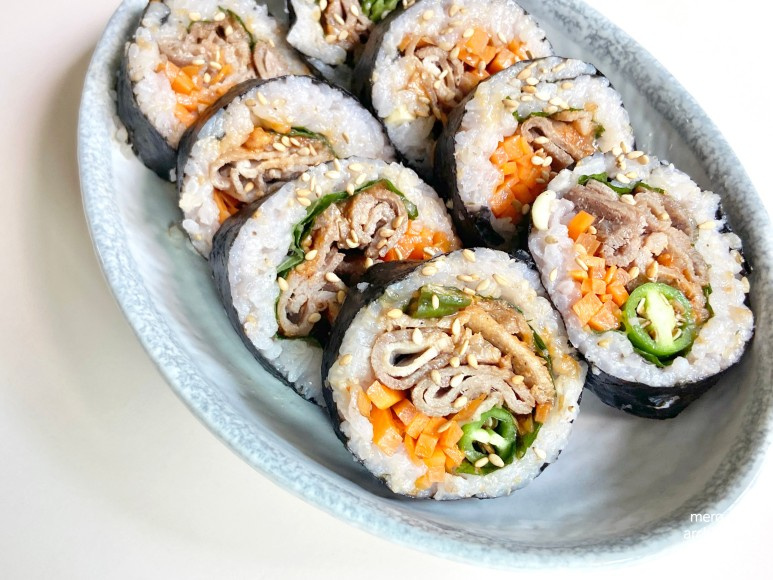Flavorful Pork Belly Kimbap: The Ultimate Way to Use Leftover Meat!
How to Make Pork Belly Kimbap Using Leftover Pork Belly or Beef Brisket

Got some leftover meat from a previous meal? Don’t let it go to waste! I had some beef brisket left over from a generous purchase, and while thinking about how to use it, I remembered making delicious pork belly kimbap. While I used beef brisket this time, this recipe is wonderfully versatile! You can use leftover pork belly, thinly sliced pork (daepae samgyeopsal), or even seasoned bulgogi or jeyuk bokkeum. No matter what meat you use, you’ll end up with a satisfying and flavorful kimbap. This recipe is perfect for a special treat or a hearty meal. Let’s get started!
Key Ingredients- Beef brisket or pork belly/thinly sliced pork 300g
- Ssamjang (Korean soybean paste) 2 Tbsp
- Perilla leaves (깻잎) 6 leaves
- Chili peppers (like Cheongyang peppers) 3-4
- Carrot 1/2
- Black pepper, a pinch
- Cooked rice, enough for 2 bowls
- Sesame oil 1 Tbsp
- Sesame seeds or ground sesame seeds 1 Tbsp
Cooking Instructions
Step 1
First, wash and prepare your vegetables for the kimbap. Pat the perilla leaves dry. Trim the stems off the chili peppers and slice them thinly, or leave them whole if you prefer. Peel the carrot and cut it into thin julienne strips. Cutting them thinly will prevent them from burning while stir-frying.

Step 2
Seasoning the rice is crucial for delicious kimbap! In a bowl of warm cooked rice (about 2 bowls’ worth), add 1 Tbsp of sesame oil and 1 Tbsp of sesame seeds. Mix them thoroughly. (Tip: If you have leftover cooked multi-grain rice, it works wonderfully too!)

Step 3
Now it’s time to cook the star ingredient: the meat! Heat a pan over medium-high heat. Add your beef brisket (or your chosen leftover meat) and sprinkle lightly with black pepper to get rid of any gamey odors. It’s best to cook it quickly over high heat.

Step 4
Once the meat is cooked, it’s important to drain off excess oil. Place the cooked meat on paper towels and gently press down to absorb any remaining grease. This step prevents your kimbap from becoming too greasy.

Step 5
In a separate pan, add a little cooking oil and stir-fry the julienned carrots. Sauté them until they are slightly softened but still have a little bite. Season lightly with salt. This process helps bring out the natural sweetness of the carrots.

Step 6
This is the foundation of kimbap making! Prepare your sheets of dried seaweed (gim) for kimbap. Place a sheet shiny-side down on your work surface. You’ll be spreading the rice on the rough side.

Step 7
Spread the seasoned rice evenly over the seaweed sheet. Cover about two-thirds to three-quarters of the seaweed, spreading it thinly and widely. If you use too much rice, it will be difficult to roll tightly.

Step 8
Place the prepared perilla leaves on top of the rice. The fragrant perilla leaves will add wonderful flavor to your kimbap. Next, spread a thin layer of ssamjang over the perilla leaves. The savory depth of the ssamjang pairs perfectly with the meat.

Step 9
Now it’s time to assemble and roll the kimbap. Arrange the drained cooked meat neatly on top of the perilla leaves, closer to the edge of the seaweed that you’ll start rolling from. Layer the stir-fried carrots, sliced chili peppers, and any other prepared ingredients over the meat. Hold all the fillings firmly in place as you roll the seaweed tightly from the bottom up.

Step 10
Let’s cut the kimbap to show you the beautiful cross-section. Doesn’t this pork belly kimbap look incredibly appetizing? The rich meat combined with fresh vegetables creates a delicious and nutritious masterpiece!



